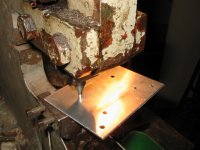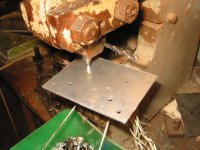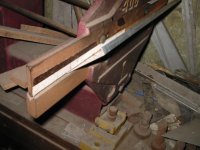Is there an easy way to cut apertures into thin metal panels like the ones that come with enclosures? I can drill holes easily on aluminium metal, have not tried on steel, but am not sure what to do for square openings. On a PCB I would start with a round hole and then I'd insert the jigsaw blade and go that way, but that tends to destroy blades almost instantly and also on metal it'd be impossible.
thanks
thanks
Also, use a small (Dremel) grinder/cutter disk (in a tool like the Dremel)
I agree, that's the easiest on thin sections. Also place masking tape on first then draw your cutout on this, this prevents scratches.
Mac
I agree, that's the easiest on thin sections. Also place masking tape on first then draw your cutout on this, this prevents scratches.
Mac
Yes, that's true, never (ever
I hate iron, so won't comment on it.
Plus *really* you need industrial type machinery to deal with it.
Now, aluminum is better for the home builder.
For one-offs you can drill the approximate shape and finish with a nibbler (best) or filing , if you want to work out at the same time.
Personally I had to buy punching machines with an assortment of dies, but the next best is finding a friendly neighbourhood shop which specializes in "Aluminum Carpentry", those guys who make custom windows, sliding doors, office divisions, etc.
By trade needs they usually have a specialized puncher with an assortment of dies.
Any square or rectangular one can make a bigger rectangular one in so many "bites".
Be sure to visit them carrying an ice cold sixpack or a couple cigarette packs or whatever, so you are always welcome.
Mind you, only aluminum.
They hate iron too, because its hardness will at least take the sharpness of their tools and at worst damage them.
Plus *really* you need industrial type machinery to deal with it.
Now, aluminum is better for the home builder.
For one-offs you can drill the approximate shape and finish with a nibbler (best) or filing , if you want to work out at the same time.
Personally I had to buy punching machines with an assortment of dies, but the next best is finding a friendly neighbourhood shop which specializes in "Aluminum Carpentry", those guys who make custom windows, sliding doors, office divisions, etc.
By trade needs they usually have a specialized puncher with an assortment of dies.
Any square or rectangular one can make a bigger rectangular one in so many "bites".
Be sure to visit them carrying an ice cold sixpack or a couple cigarette packs or whatever, so you are always welcome.
Mind you, only aluminum.
They hate iron too, because its hardness will at least take the sharpness of their tools and at worst damage them.
And more idea's are here Make Square Holes in Aluminum Sheet Metal
Good Stuff! Thanks for posting this link.
Hand operated screw-type hole cutters are a great tool, I have used them myself when I started doing this (43 years ago) but are reasonable if you need only a few (as in tube sockets) and all others can be drilled.
And prices are sensible only if round (because they can be made by cheap lathe operations).
But when you need square or other odd shapes, prices go sky high, plus you have no variety.
And it's impossible to get small rectangular ones , such as for rocker switches and such.
And forget slider pots !!
So I hunted liquidated small factories auctions, and bought second or third hand machines "by the pound", which otherwise were going to the melting pot.
Here's one of my vertical punchers, in the background you'll see some sets of male/female punches and dies, round from 3mm (Leds) to 13mm (20mm Fuse Holders, 1/2" neck switches, etc.) plus 9x21mm (Rocker switches) , 40mm and 65mm x 3 mm (slider pots), 7x9mm rounded (rack panel "ears" ) and so on.
On other larger machines I have dies up to 63x63 mm.
Here I'm punching round 4mm holes in heat sinks attached to my 60/100W power amps.
On the bottom right of my chassis folder picture, you'll see some other punch-and-die pairs.
Yes, there's a little too much dust everywhere.
I'll have some serious words with the cleaning lady
And prices are sensible only if round (because they can be made by cheap lathe operations).
But when you need square or other odd shapes, prices go sky high, plus you have no variety.
And it's impossible to get small rectangular ones , such as for rocker switches and such.
And forget slider pots !!
So I hunted liquidated small factories auctions, and bought second or third hand machines "by the pound", which otherwise were going to the melting pot.
Here's one of my vertical punchers, in the background you'll see some sets of male/female punches and dies, round from 3mm (Leds) to 13mm (20mm Fuse Holders, 1/2" neck switches, etc.) plus 9x21mm (Rocker switches) , 40mm and 65mm x 3 mm (slider pots), 7x9mm rounded (rack panel "ears" ) and so on.
On other larger machines I have dies up to 63x63 mm.
Here I'm punching round 4mm holes in heat sinks attached to my 60/100W power amps.
On the bottom right of my chassis folder picture, you'll see some other punch-and-die pairs.
Yes, there's a little too much dust everywhere.
I'll have some serious words with the cleaning lady
Attachments
Great I'd ask you to do some work for me but you are in Buenos Aires...Hand operated screw-type hole cutters are a great tool, I have used them myself when I started doing this (43 years ago) but are reasonable if you need only a few (as in tube sockets) and all others can be drilled.
And prices are sensible only if round (because they can be made by cheap lathe operations).
But when you need square or other odd shapes, prices go sky high, plus you have no variety.
And it's impossible to get small rectangular ones , such as for rocker switches and such.
And forget slider pots !!
So I hunted liquidated small factories auctions, and bought second or third hand machines "by the pound", which otherwise were going to the melting pot.
Here's one of my vertical punchers, in the background you'll see some sets of male/female punches and dies, round from 3mm (Leds) to 13mm (20mm Fuse Holders, 1/2" neck switches, etc.) plus 9x21mm (Rocker switches) , 40mm and 65mm x 3 mm (slider pots), 7x9mm rounded (rack panel "ears" ) and so on.
On other larger machines I have dies up to 63x63 mm.
Here I'm punching round 4mm holes in heat sinks attached to my 60/100W power amps.
On the bottom right of my chassis folder picture, you'll see some other punch-and-die pairs.
Yes, there's a little too much dust everywhere.
I'll have some serious words with the cleaning lady
True enough.
But the pictures are mainly to have an idea about how the actual hand operated machines look like, so you recognize them and see it's not rocket science.
And this points to my suggestion about searching for a local shop making Aluminum doors, windows, and such.
They often use a machine very similar to these, which often has a "tool carrier" with 4 or 5 "standard" dies which they use.
If you get access to such a shop, many different useful holes can be made combining them creatively.
Even big manufacturers "cheat" that way, if you look at a modern Marshall tubed amp chassis, you'll see that the large square cutout to fit the transformer flush with the chassis, is made out a lot of smaller (say, 1/2" square) holes, you can clearly see the "bites" along the edges.
Of course, they use CNC punching machines, but the principle is the same.
OR: try to visit a shop/factory stamping parts for the Car industry.
I use one such shop to stamp and punch my speaker frames ... basically using dies they already had to make car wheels and hubs
The basic idea is to find somebody who needs the same operations done, no matter what they actually manufacture.
One guy who for ages helped me make chassis was a subcontractor for an old mechanical grocery balance/scale maker, how's that?
I was also helped by guys who had small tin shops, the kind who custom make rain gutters, air conditioning conduits and such.
But the pictures are mainly to have an idea about how the actual hand operated machines look like, so you recognize them and see it's not rocket science.
And this points to my suggestion about searching for a local shop making Aluminum doors, windows, and such.
They often use a machine very similar to these, which often has a "tool carrier" with 4 or 5 "standard" dies which they use.
If you get access to such a shop, many different useful holes can be made combining them creatively.
Even big manufacturers "cheat" that way, if you look at a modern Marshall tubed amp chassis, you'll see that the large square cutout to fit the transformer flush with the chassis, is made out a lot of smaller (say, 1/2" square) holes, you can clearly see the "bites" along the edges.
Of course, they use CNC punching machines, but the principle is the same.
OR: try to visit a shop/factory stamping parts for the Car industry.
I use one such shop to stamp and punch my speaker frames ... basically using dies they already had to make car wheels and hubs
The basic idea is to find somebody who needs the same operations done, no matter what they actually manufacture.
One guy who for ages helped me make chassis was a subcontractor for an old mechanical grocery balance/scale maker, how's that?
I was also helped by guys who had small tin shops, the kind who custom make rain gutters, air conditioning conduits and such.
I think I can buy a few dies, the round ones are quite cheap. Metal Hole Cutters Sheet metal Qmax punches
I am not sure if I will need a tool on top of that, I will call them on Monday to ask.
Another question is this: can I use a smaller size square die to open a larger hole? Can it "nibble" or "snap" on just one of its sides? Or will the asymmetrical pressure bend and break the die and/or the bolt that is used to fasten it?
I am not sure if I will need a tool on top of that, I will call them on Monday to ask.
Another question is this: can I use a smaller size square die to open a larger hole? Can it "nibble" or "snap" on just one of its sides? Or will the asymmetrical pressure bend and break the die and/or the bolt that is used to fasten it?
1) to use these you drill a hole for the bolt, screw it around the metal sheet and start to turn the bolt with some suitable tool, by hand.
2) you can nibble along one edge on a punch/die set which is mounted on a strong industrial machine, which will do its best to keep it aligned, unless you want to make something really silly, as cutting 3/8" rebar with the tip of a slider pot punch, but on a "floating" screw operated hand held punch, don't think so.
Well, maybe you can try your luck on 0.5 or 1mm thick aluminum, but nothing heavier.
2) you can nibble along one edge on a punch/die set which is mounted on a strong industrial machine, which will do its best to keep it aligned, unless you want to make something really silly, as cutting 3/8" rebar with the tip of a slider pot punch, but on a "floating" screw operated hand held punch, don't think so.
Well, maybe you can try your luck on 0.5 or 1mm thick aluminum, but nothing heavier.
Those aluminium end plates found on the prefabricated enclosures are typically 1.5mm thin.
There is another way to build end panels using a fibreglass PCB rather than aluminium but every time I did this I had to change jigsaw blades almost on every cut. maybe I need to buy blades made from unobtainium.
There is another way to build end panels using a fibreglass PCB rather than aluminium but every time I did this I had to change jigsaw blades almost on every cut. maybe I need to buy blades made from unobtainium.
Fiberglass epoxy is murder on cutting tools.
You need "hard metal insert" a.k.a. "Widia" blades or better (Diamond).
That's why I still make my PCBs out of paper/phenolic material, easy to cut and drill.
Not as strong, but I use thick pads and tracks.
If it was good enough for Zillions of TVs, consumer stuff and old Guitar amps, it's good enough for me.
You need "hard metal insert" a.k.a. "Widia" blades or better (Diamond).
That's why I still make my PCBs out of paper/phenolic material, easy to cut and drill.
Not as strong, but I use thick pads and tracks.
If it was good enough for Zillions of TVs, consumer stuff and old Guitar amps, it's good enough for me.
Yes I have ordered the fibreglass+paper composite boards for easier hole cutting.
I am looking at the Q-MAX hole cutters, the square ones, and the method of use is you make a hole first, pass the screw through, and then you tighten so it cuts a clean hole. Now suppose I want to cut a rectangular shape, would I be able to use the same cutters? Here is a link: http://www.lawson-his.co.uk/metric-metal-hole-cutters-c3487
I am looking at the Q-MAX hole cutters, the square ones, and the method of use is you make a hole first, pass the screw through, and then you tighten so it cuts a clean hole. Now suppose I want to cut a rectangular shape, would I be able to use the same cutters? Here is a link: http://www.lawson-his.co.uk/metric-metal-hole-cutters-c3487
Last edited:
Maybe you mean either fibreglass epoxy or paper epoxy or phenolic?fibreglass+paper composite boards
As of the cutters, if you get a square cutter, why not?
Apparently it is two layers of fibreglass sandwiching one layer of paper. Or something. 
I am asking about the cutters because you first need to make a hole with the drill in order to pass the screw through - if you want to nibble at one edge there will be no hole to guide you and the punch will be biting on one edge only - will it work? The cutting edge of the punch is not flat, it is rounded - but when you want to bite a little bit off I think you'd need a flat edge.
I am asking about the cutters because you first need to make a hole with the drill in order to pass the screw through - if you want to nibble at one edge there will be no hole to guide you and the punch will be biting on one edge only - will it work? The cutting edge of the punch is not flat, it is rounded - but when you want to bite a little bit off I think you'd need a flat edge.
- Status
- This old topic is closed. If you want to reopen this topic, contact a moderator using the "Report Post" button.
- Home
- Design & Build
- Equipment & Tools
- Cutting openings in metal panels


